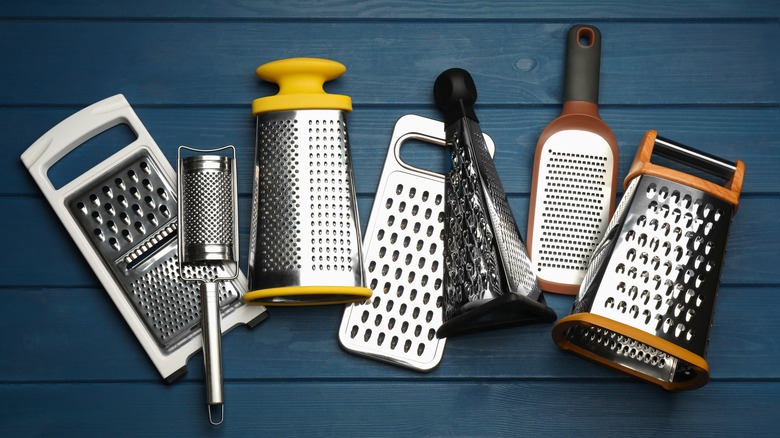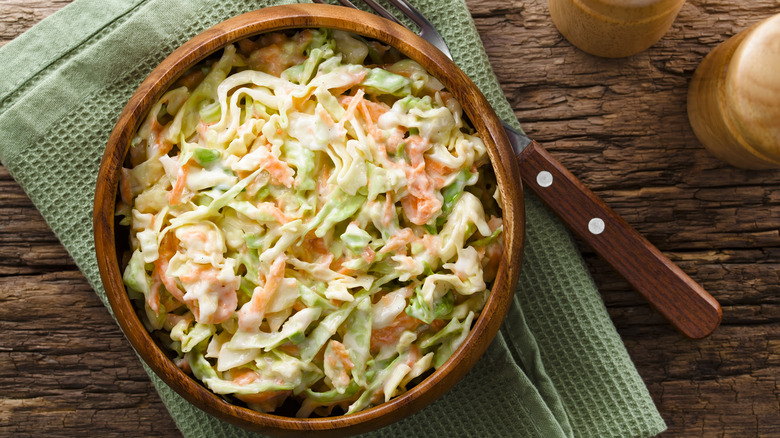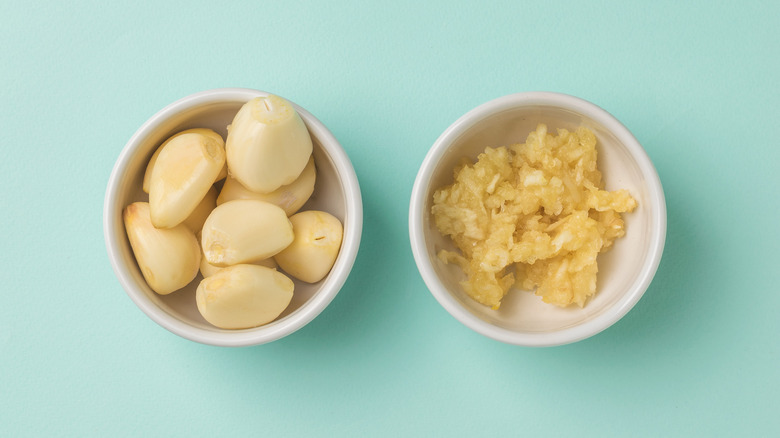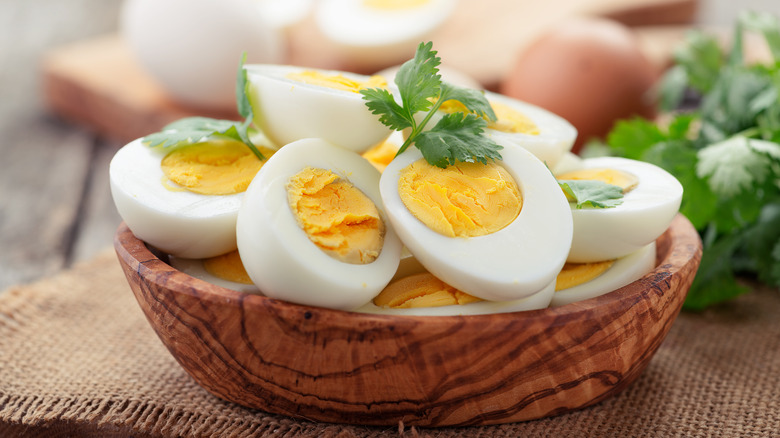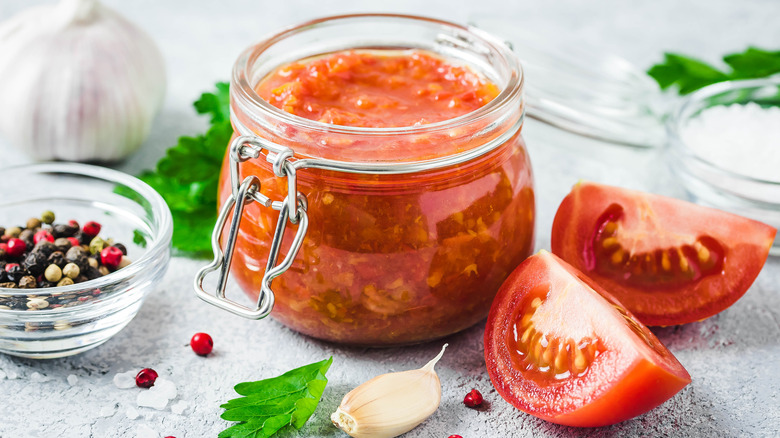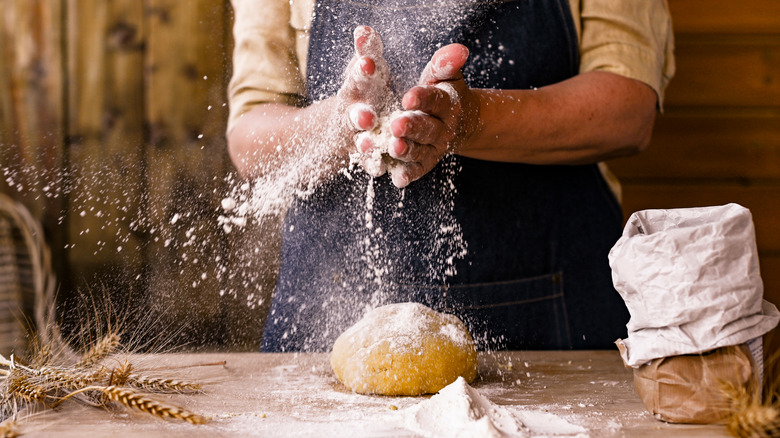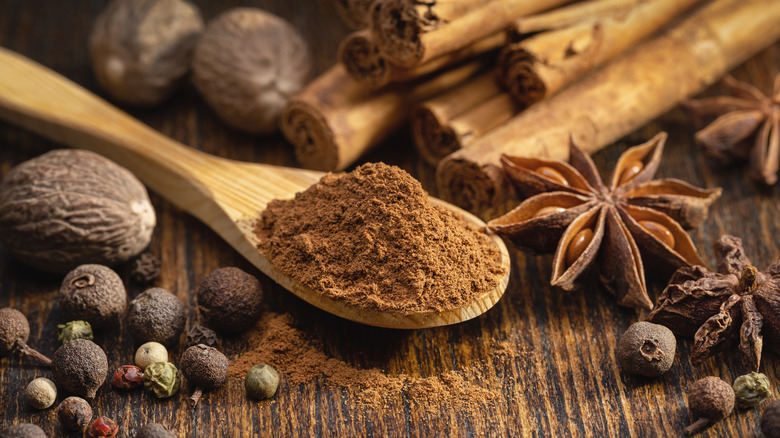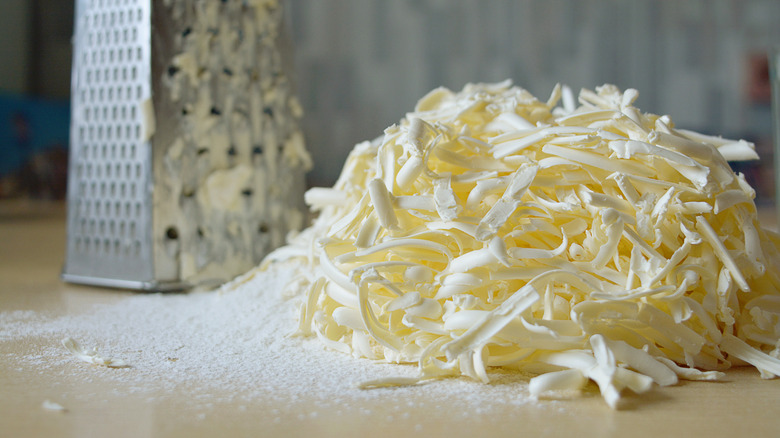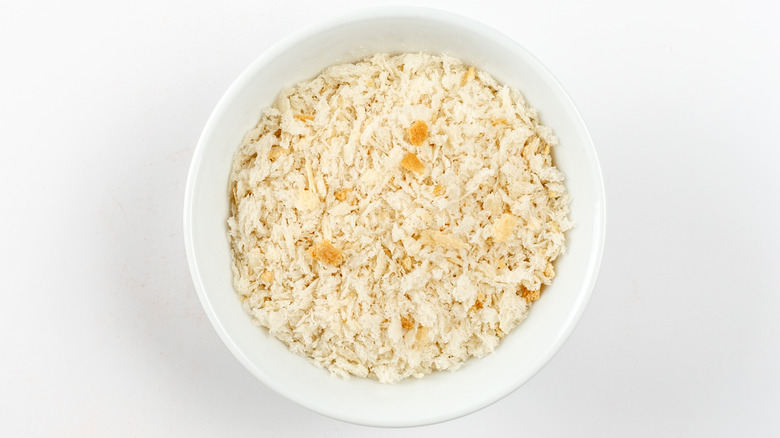Unique Ways To Use Your Box Grater
If your box grater sits in a kitchen cabinet until it's time to shred a block of cheese, it is not reaching its full potential. Your box grater has four sides for a reason, and three of them are too widely overlooked and ignored by home cooks, according to Chatelaine. Box graters have a vast range of uses for a variety of ingredients and applications.
Meal prep can be made a breeze by mincing, slicing, or shredding vegetables. Quick additions to a hot pan can be done swiftly without having to chop an ingredient on a cutting board. A final touch can be made to a dish that will not only brighten its appearance but also bring the entire plate together. Your box grater can help cut steps in half when baking spontaneously as well as step up your spice game without having to purchase an expensive spice grinder.
Overall, it is time you make your box grater's place in the cabinet worth it. Here are 10 ways you can do so.
De-stem herbs
Fresh herbs enhance whatever they are added to, but the task of removing them from their stem can be painstaking and time-consuming. There are herb strippers on the market made specifically for this task, but single-use kitchen utensils aren't always the best option for kitchen drawers already packed with gadgets.
TikTok offers a solution: a simple hack for stripping your herb sprigs with ease. As demonstrated by user anet_shevchenko, simply insert a sprig into the larger-holed side of your box grater and grip the stem from the other side. Pull the sprig through the grater and you'll have a bare stem and a bunch of herbs ready for use, for the most part.
This hack does better with some herbs than others, per Better Homes & Gardens. For example, more woody herbs like rosemary that have a more robust stem are perfect for this hack. The woman in the viral TikTok video used her grater to de-stem a sprig of parsley. More delicate and irregularly sized herbs like mint, on the other hand, may not work as well. Regardless, this use of your grater is worth a try. The result could reduce your prep time considerably.
Shred coleslaw vegetables
As warmer weather approaches, barbecues and cookouts will start filling up boxes on your calendar. There is always room for improvement with the crowd-pleasing staples we know and love and, of course, homemade always trumps store-bought. Coleslaw is one of those barbecue staples, and preparing a delicious, creamy, crunchy, refreshing coleslaw yourself is much easier than you may think, especially with your box grater.
The large-holed side of your box grater is the perfect size for shredding the cabbage, carrots, and any other veggies you like in your coleslaw. Shredding the vegetables down to size using a grater is a far more time efficient method than chopping and slicing them with a knife. Plus, shredding with a box grater will ensure all of the vegetables are uniform in size, making for a smoother, more structured coleslaw with no pieces chunkier or skinnier than others.
Additionally, coleslaw is at its best when made ahead of time. As Allrecipes explains, salt helps draw moisture out of the vegetables, so leaving your coleslaw to rest an hour or two before serving will enhance its crispiness. This, along with the ease of the box grater, is a win-win for both time efficiency and taste.
Mince garlic
There are more than a few recipes in the world that require garlic, and the application of garlic comes in a variety of forms. Some recipes call for whole cloves, some call for them crushed, and some sliced. More often than not, however, your garlic needs to be minced or finely chopped. This is because the more the structure of a garlic clove is broken down, the more flavor is exuded (via Cooking Light). There are kitchen gadgets specifically made to mince or finely chop garlic with ease. However, they take up extra space in your kitchen drawer and garlic presses, in particular, are a hassle to clean. Sometimes, it's easier to just buy and use pre-jarred minced garlic, but your taste buds are sure to not like that nearly as much as fresh garlic.
Luckily, your box grater has a side with holes sized in between the larger and the tiniest, perfect for breaking down garlic cloves to their most aromatic and flavorful form. This method is not only time-efficient, but it cuts down on utensils to clean, according to Melanie Cooks. Also, when recipes call for the addition of minced garlic to an already hot pan, time is of the essence since garlic is quick to burn. With a grater, you can easily monitor the amount you add in quick and controlled fashion without having to turn away from the stovetop to remove garlic skin from your press or add more off your cutting board.
Crumble hard-boiled eggs
Hard-boiled eggs are one of the easiest food items to cook and they have many different applications. They can be diced and used for egg salad or have their yolks removed and used for deviled eggs. The easiest way to do so, predictably, is with your box grater.
Instead of breaking down a hard-boiled egg with either your hands or a knife, grating them with the larger-holed side of your box grater makes the egg pieces more fluffy and more easily incorporated into the other ingredients, according to Cuisine at Home. Using a grater helps keep the hard-boiled eggs from getting smashed into a single, dense mass and instead keeps them more aerated and light.
Your grater is also a great method for crumbling hard boiled eggs for avocado toast. As just stated, the lighter, fluffier result by grating makes for more uniform, evenly distributable eggs over your bread.
Puree tomatoes
Tomato sauce is another staple best made in your own kitchen. The instruments most commonly used, however, are not always the most kitchen-friendly. Eviscerating your tomatoes with a food processor is easy, yes, but the cleanup that follows can be a chore. Some opt for their blender to break down their fresh tomatoes, but a thicker, chunky sauce can easily be lost and you'll be left with a sauce too thin for pasta to catch.
Your box grater, on the other hand, will provide you with tomatoes equal parts mashed, juiced and chunked, according to Growing Tomatoes. For those not keen on including tomato skins in your sauce, the grater will catch most of the skin within its blades, allowing everything else to pass through. Then, all that needs to be done for your homemade sauce is to add your now-perfectly proportional tomatoes to your pot and a simple wash of your grater.
Shape homemade pasta
While the boxed, dry pasta you have been cooking your whole life has served you well, homemade, fresh pasta is a step forward for home cooks. The only problem is, forming, kneading, rolling, and shaping pasta dough is extremely time-consuming, and if you do not have a pasta making machine and are just using a rolling pin, the odds of success on your first try are slimmer than ideal.
Your box grater, however, can help make the challenge of homemade pasta less daunting, according to Lifehacker. You may not be able to form pastas like ravioli or linguini, but grating your rested pasta dough with the larger-holed side makes for a rustic alternative and a full-proof way to make sure your pasta dough does not go to waste.
Simply grate, cook to your liking, and toss with your favorite pasta sauce, and you'll have fresh, homemade pasta right out of your own kitchen. While the shape of your pasta may not be authentic or your personal favorite, you'll now have some pasta dough practice you can reference in the future.
Enhance spices
The pre-ground, factory-sealed spices you buy at the supermarket and replenish on your spice rack are obvious essentials. Freshly ground spices take them to a whole other level. Not only do freshly ground spices taste better, they stay fresh for a longer amount of time and can be bought in bulk to save money, according to FinaMill. This said, spice grinders to grind your freshly ground spices can be expensive and take up valuable space in your kitchen cabinet. Thankfully, your box grater can provide a similar function.
Some spices that can be grated include whole cinnamon sticks, whole nutmeg, cardamom pods, and ginger root. These are common spices typically mixed in with other ingredients but can also be simple, aromatic, and tasty garnishes. Nutmeg is a great finishing touch over a latte and cinnamon over almost anything, according to The Grate Plate. The smaller or smallest-holed side of your grater is best for grinding fresh spices. Once you give it a try, the aromas that fill your kitchen will be a reason to do it every chance you can.
Grate butter
Deciding to spend an afternoon baking cookies or other pastry can be quickly dismissed when your recipe calls for the butter to be softened to room temperature. You then must either microwave your butter cautiously so as not to melt it, wait an hour or so before you begin, or decide to skip the baking venture altogether.
But the next time an impromptu baking session makes its way into your day and the butter is cold and hard, don't abandon the idea so quickly; instead, grab your box grater and use it to grate your cold butter into tiny pieces. Not only will this make for more manageable and easily incorporated butters, the breakdown will help the butter reach room temperature much faster, according to Kitchn.
Additionally, some recipes, such as that of scones and puff pastry, call for the incorporation of frozen butter. Obviously, the frozen butter cannot be added in whole sticks and slicing frozen butter into tiny pieces is not only meticulous and messy, the handling of the frozen butter will cause it to melt, rendering it counterproductive. The solution? Your box grater, which is not only a faster way but will result in easy-to-incorporate butter flakes.
Make breadcrumbs
The use for breadcrumbs goes way beyond breading chicken or binding meatballs. breadcrumbs can top mac and cheese, be tossed in a salad, or even sprinkled over your favorite dessert to add another layer of texture. Buying breadcrumbs from the store is the usual play, but homemade breadcrumbs are not only super simple, their taste and texture is fresher.
Using your grater to make breadcrumbs is also a great method because you can make them any size you wish. You can use the medium-holed side for more dense breadcrumbs or the smallest-holed side to make them extra fine. While you can grate fresh bread to make your breadcrumbs, toasted or even stale bread works best, according to The Tasty Tip. The ridged holes of the greater will be able to grind the bread easier if it has a hard surface.
So the next time you find yourself with leftover or stale bread, put your box grater to use and grind out some fresh breadcrumbs. Not only are they delicious, you'll be cutting down on waste.
Flake chocolate
Grated chocolate is a super easy way to add a touch of decadence and class to a dessert. While any chocolate can be grated, according to MyRecipes, there are some that work better than others. For example, dark chocolate with a high percentage of cacao is harder and will pass through your grater more easily and evenly. Softer chocolates like white and milk chocolate can also be grated, but should be chilled ahead of time to avoid any melting or uneven pieces. Grating chocolate that has been chilled ahead of time will also make for easier cleaning, as no bits will have melted onto your grater.
Chocolate is another ingredient that can be grated to the size of your liking: tiny ribbon flakes can be made using the larger-holed side and a fine chocolate dust can be made with the smallest. Large, elongated ribbons can even be shaved from the side with the three large blades. These larger shavings are the perfect garnish for a cake or other larger baking project.
Whether you just scoop some ice cream into a bowl or are about to present a centerpiece of homemade cannoli, a light dusting of chocolate from your box grater will take your confections to the next level. Despite the minimal effort, the result will make your treats look irresistible.
